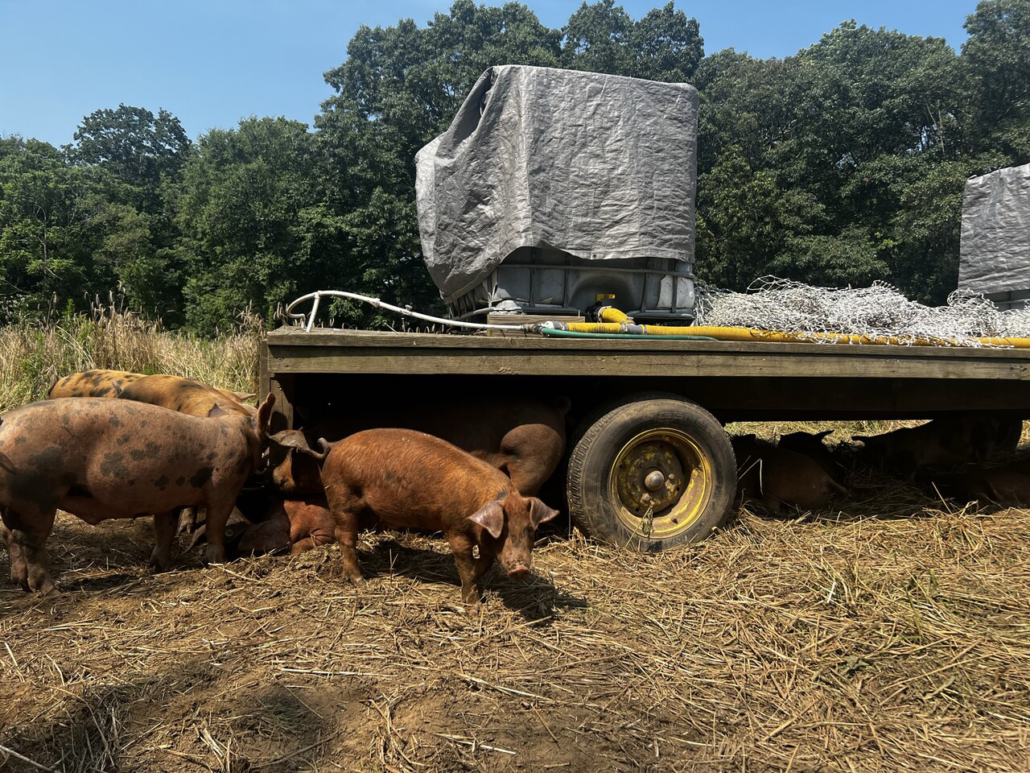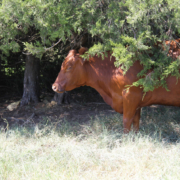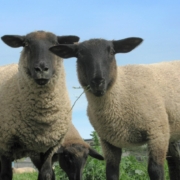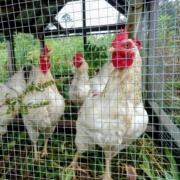Throw Some Shade: Protecting Livestock from Heat Stress
 Print This Post
Print This Post
By Nina Prater, NCAT Agriculture Specialist
As the summer heat ramps up around the country, it’s a good time to make sure we livestock producers are protecting our animals from heat stress. It is beneficial for their comfort and it improves their productivity, as well.
Here in Arkansas where I live and raise cattle, goats, laying hens, and a few ducks, the summer temperatures can be punishing. Not only is it hot – frequently over 100 degrees – it can also be ridiculously humid. When high temperatures pair with high humidity, it can become downright dangerous. In this blog, I’ll briefly cover a few ways we can keep our livestock safe in the heat.
Shade
For all livestock species, shade is critical in making sure they remain healthy and productive throughout the summer. When doing managed grazing of cattle, sheep, or goats, this can mean making sure part of each paddock includes some trees. If you don’t have perfectly placed trees throughout your paddocks, you can use portable shade structures that you rotate along with your portable mineral feeder and water tanks when you move your livestock to fresh pastures. Permanent sheds and barns are more expensive and less flexible in terms of rotational grazing management, but it is another option for providing shade.
A relatively new way of providing shade for livestock is grazing around solar panels. Check out this webinar to learn more about solar grazing.
Water
Staying hydrated is also critical to beat the heat, but make sure your water source doesn’t get stagnant. In hot conditions, algae and bacterial growth can lower water quality and reduce intake. Small troughs with a high-volume automatic valve work best for rapid water turnover.
Choosing the Right Animals
Some livestock species handle heat better than others. Choosing the right enterprise to match your climate will lead to long-term success. For example, sheep and goats tolerate heat better than cattle, as a rule. And goats tolerate heat better than sheep, and haired sheep are more tolerant than wool sheep. If you have wool sheep, timing your shearing to match the season is important. In this article, a veterinarian explains, “Wool acts as insulation against heat as well as against the cold. Ideally, wool sheep should be sheared in the spring, so they have some wool growth by the time summer rolls around to help dissipate the heat.” And we all know that dark colors absorb more heat than lighter colors, so black cattle often struggle more than lighter colored breeds. Choose your animals wisely if heat is a challenge where you live.
Hogs have different considerations. They need wallows and shade since they cannot sweat. Their love of wallowing, however, means they can cause damage to natural sources of water like ponds or creeks. ATTRA’s publication, Hogs: Pastured or Forested Production, is a great resource for more information on keeping hogs happy.

A great setup where a trailer holding the water tank provides shade and can be moved around the paddock periodically. Photo: Lee Rinehart, NCAT
And we can’t forget poultry! Heat stress for chickens, turkeys, and other poultry species can cause major productivity setbacks. ATTRA has a wide range of resources on providing proper housing for poultry, including the publication Pastured Poultry: Egg Production.
Avoid Unnecessary Stress
Lastly, the time of day you work your animals is important. To avoid unnecessary animal stress, never work them in the heat of the day. Early morning is best. (And you’ll be safer and more comfortable too!)
If you take the appropriate precautions, heat becomes another manageable risk among the many risks farmers and ranchers juggle all year round. Avoid heat stress for yourself and your livestock, and in no time, we’ll all be worried about frozen water lines again.
Related ATTRA Resources:
Other Resources:
Shade Options for Grazing Cattle, University of Kentucky
This blog is produced by the National Center for Appropriate Technology through the ATTRA Sustainable Agriculture program, under a cooperative agreement with USDA Rural Development. ATTRA.NCAT.ORG.










 USDA/FPAC photo by Preston Keres
USDA/FPAC photo by Preston Keres
